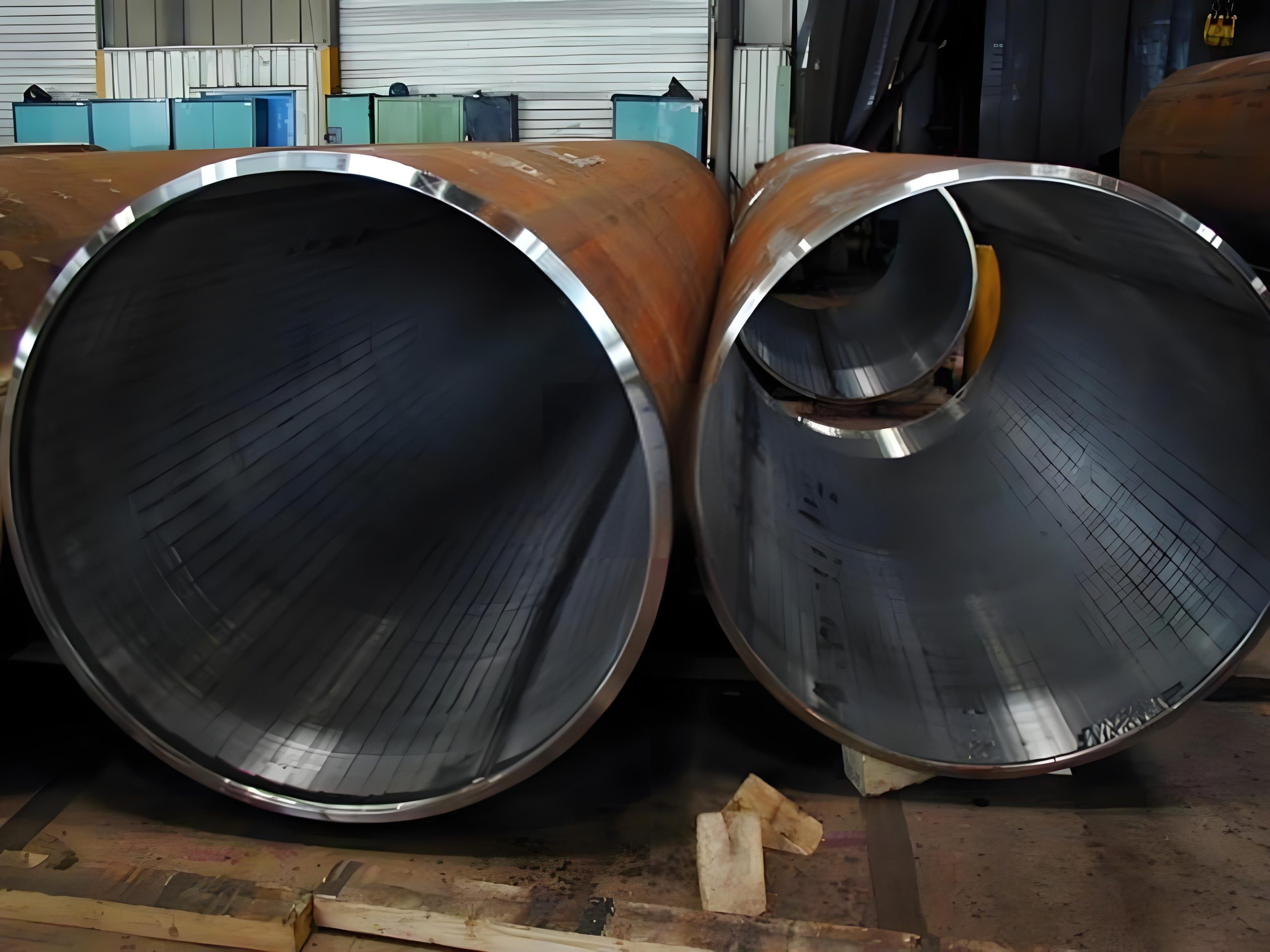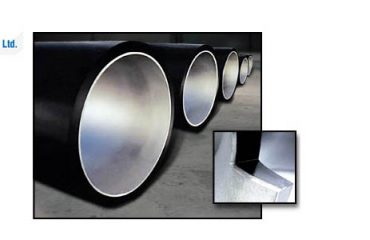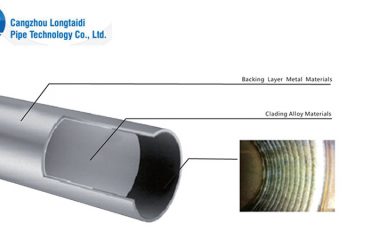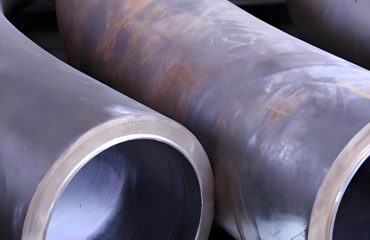
Специфікація плакованих труб
Плаковані труби, також відомий як плаковані труби або CRA (Стійкий до корозії сплаву) Плаковані труби, складаються з основної труби з вуглецевої або легованої сталі з внутрішнім або зовнішнім шаром корозійностійкого сплаву. Ці труби поєднують механічну міцність сталевої основи з корозійною стійкістю сплаву, що робить їх ідеальними для важких умов у таких галузях промисловості, як нафтова та газова, Хімічна обробка, і виробництво електроенергії.
Основні характеристики
-
Основні матеріали:
- API 5L клас B, Х42, Х46, X52, X56, X60, X65, X70, X80
- ASTM А106 гр.Б, ASTM A333 Gr.6, ASTM A335 Cr-Mo сплави (P5, P11, P22, P9, P91)
-
Облицювальні матеріали:
- Нержавіюча сталь: SS 304/304L, SS 316/316L, SS 317/317L, двухшпиндельный 2205, двухшпиндельный 2506, Супер дуплекс 2507, Сплав 254 МИ, 904L
- сплави нікелю : Incoloy 825, INCONEL 625, INCONEL 59, Сплав 31, AL6XN, Сплав 20, Монель 400
- Інші сплави: Hastelloy C-276, Сорти титану 2, 5, 7, 9, 12, Цирконій R60702, різні мідні сплави
-
виробничі стандарти:
- API 5LD
- ASTM A240, A263, A264, A265, B898, B424, B443, B619, B622, B675, B265, B551
-
Розміри:
- Діапазон діаметрів труб: Ф50мм-Ф1800мм
- Товщина стінки вкладиша: 0.5мм-3,5 мм
- Довжина: ≤15м
-
Обробка поверхні :
- Композитна технологія цифрової підводної дефлаграції
- Гідравлічна композитна технологія
- Наплавлення торців труб і розточування внутрішньої стінки
-
Перевірка та тестування:
- Ультразвуковий контроль (OUT)
- Радіографічне тестування (RT)
- Гідростатичні випробування
- Механічні випробування (На розрив, Твердість, Вплив)
- Випробування на корозію
Процес облицювання труб
Плакування передбачає склеювання корозійностійкого сплаву (CRA) до основної труби з вуглецевої або легованої сталі. Цей процес може бути досягнутий різними методами, кожен зі своїми перевагами та застосуванням:
Способи облицювання
-
Гаряча прокатка:
- Включає згортання CRA та основного матеріалу разом при високих температурах для досягнення металургійного зв’язку.
-
Коекструзія:
- Обидва матеріали екструдуються разом, забезпечення щільного зчеплення шляхом одночасної деформації.
-
накладення шва:
- КРА приварюється до основного матеріалу, створення шару корозійностійкого металу.
-
Вибухове склеювання:
- Використовує контрольовані вибухи для приєднання CRA до основного матеріалу. Цей метод особливо корисний для великих або складних форм.
-
Порошкова металургія:
- Порошок CRA наноситься на основний матеріал, а потім спікається для створення зв’язку.
-
механічне склеювання:
- Включає розширення або звуження вкладиша CRA для щільного прилягання до основної труби. Цей метод менш міцний, ніж металургійне з’єднання, але корисний для певних застосувань.
Етапи процесу
-
Підготовка базової труби:
- Очищення та перевірка основної труби, щоб переконатися, що вона відповідає необхідним стандартам.
-
Застосування обшивки:
- Нанесення шару CRA одним із зазначених вище методів.
-
термічна обробка:
- Для зняття напруги та забезпечення міцного зчеплення між матеріалами.
-
Механічна обробка:
- Остаточне формування, наплавлення, перевірка на відповідність специфікаціям розмірів і якості.
-
Тестування та перевірка:
- Комплексне тестування для забезпечення цілісності та ефективності плакованої труби.
Що таке плаковані труби?
Плакована труба — це композитна труба, яка поєднує в собі механічну міцність базової труби з вуглецевої або легованої сталі та корозійну стійкість шару CRA. Процес облицювання з’єднує CRA з основним матеріалом, забезпечує підвищену довговічність і стійкість до корозійних середовищ. Ці труби мають вирішальне значення в галузях промисловості, де важливі як механічна міцність, так і стійкість до корозії, таких як нафта і газ, нафтохімічної, і морські програми.
Діапазон розмірів облицювальних сталевих труб
Плаковані сталеві труби бувають різних розмірів, щоб відповідати різним промисловим вимогам:
- Діапазон діаметрів труб: Ф50мм-Ф1800мм
- Товщина стінки вкладиша: 0.5мм-3,5 мм
- Довжина: До 15 метрів
Діапазон розмірів облицювальних сталевих труб (Продовження)
Ці розміри гарантують, що плаковані труби можна адаптувати до конкретних застосувань, забезпечення необхідної міцності та стійкості до корозії, необхідних для використання за призначенням. Гнучкість діапазону розмірів дозволяє налаштовувати для задоволення конкретних потреб різних промислових процесів.
Прайс лист плакованих труб
Ціна плакованих труб може істотно відрізнятися залежно від кількох факторів, включаючи основний матеріал, тип використовуваного CRA, розміри труби, і виробничий процес. Ось загальний посібник щодо того, як ці фактори впливають на вартість:
-
основний матеріал:
- ВУГЛЕЦЕВОЇ СТАЛІ: Загалом дешевше.
- Леговані сталі: Вища вартість за рахунок покращених механічних властивостей.
-
Матеріал CRA:
- Нержавіюча сталь (наприклад, 304/304L, 316/316L): Помірна вартість.
- сплави нікелю (наприклад, INCONEL 625, Hastelloy C-276): Вища вартість завдяки чудовій стійкості до корозії.
- Спеціальні сплави (наприклад, титан, Цирконій): Найвища вартість завдяки унікальним властивостям.
-
Розміри труб:
- Більший діаметр і товщі стінки збільшують вартість матеріалу.
- Довші труби вимагають більш інтенсивних виробничих процесів.
-
ВИРОБНИЧИЙ ПРОЦЕС:
- Прості способи механічного склеювання є менш дорогими.
- Просунуті процеси, такі як з’єднання вибухом або зварювання, є дорожчими.
Для конкретної ціни, рекомендується зв'язатися з виробниками або постачальниками, які можуть надати детальні пропозиції на основі точних необхідних специфікацій.
Обробка поверхні обшивки труб
Обробка поверхні плакованих труб має вирішальне значення для забезпечення довговічності та продуктивності труби в експлуатації. Процес обробки поверхні включає в себе:
-
прибирання:
- Видалення будь-яких забруднень, іржа, або накип з поверхні, щоб забезпечити чисту поверхню склеювання.
-
Шорсткість поверхні:
- Для шорсткості поверхні використовуються такі методи, як пескоструминна або піскоструминна обробка, поліпшення адгезії шару CRA.
-
Застосування CRA:
- Шар CRA наноситься за допомогою таких методів, як зварювання, Гаряча прокатка, або склеювання вибухом.
-
Обробка після обшивки:
- Термічна обробка для зняття напруги та посилення зв’язку між CRA та основним матеріалом.
- Остаточна обробка та полірування для досягнення бажаної якості поверхні.
-
Перевірка та тестування:
- Неруйнівний контроль (НК) такі методи, як ультразвукове дослідження (OUT) та радіографічне тестування (RT) використовуються для перевірки на наявність дефектів.
- Візуальний контроль для перевірки якості поверхні.
CRA матеріал заглибленої труби
Плаковані труби CRA використовують різні корозійно-стійкі матеріали, кожен вибирається на основі конкретних вимог програми:
-
Нержавіюча сталь:
- SS 304/304L, SS 316/316L, SS 317/317L
- двухшпиндельный 2205, двухшпиндельный 2506, Супер дуплекс 2507
- Сплав 254 МИ, 904L
-
сплави нікелю :
- Incoloy 825, INCONEL 625, INCONEL 59
- Сплав 31, AL6XN, Сплав 20
- Монель 400
-
Інші сплави:
- Hastelloy C-276
- Сорти титану 2, 5, 7, 9, 12
- Цирконій R60702
- різні мідні сплави
Вибір матеріалу CRA залежить від таких факторів, як тип корозії (наприклад, кісточки, щілина, корозійне розтріскування під напругою), робоча температура, і хімічне середовище.
Види плакованих труб
Плаковані труби можна класифікувати на основі методу плакування та типу використовуваного CRA:
На основі методу обшивки
-
Плаковані труби з наплавленням:
- КРА приварюють до основної труби, підходить для застосування під високим тиском.
-
Труби, покриті вибухом:
- Використовує вибухову силу для з’єднання CRA з основною трубою, ідеально підходить для складних форм і великих діаметрів.
-
Плаковані гарячекатані труби:
- CRA і основний матеріал згортаються разом при високих температурах, забезпечення міцного металургійного зв'язку.
-
Футеровані труби з механічним скріпленням:
- Вкладиш CRA механічно вставляється всередину основної труби, менш дорогий, але з меншою міцністю зв’язку.
За матеріалами CRA
-
Плаковані труби з нержавіючої сталі:
- Зазвичай використовуються через чудову стійкість до корозії та механічні властивості.
-
Труби з нікелевого сплаву:
- Висока стійкість до корозії в агресивних середовищах, такі як умови високої температури та високого тиску.
-
Труби, плаковані титаном:
- Надзвичайно стійкий до корозії від морської води та хімічних речовин.
-
Плаковані цирконієм труби:
- Використовуються в програмах, пов’язаних із сильними кислотами, завдяки їх винятковій стійкості до корозії.
Випробування та перевірка обшивки сталевих труб (Продовження)
Для забезпечення якості та цілісності плакованих труб, під час та після виробничого процесу проводиться широкий спектр випробувань та перевірок. Ці випробування призначені для перевірки механічних властивостей, стійкість до корозії, і загальна надійність труб.
Неруйнівний контроль (НК)
-
Ультразвуковий контроль (OUT):
- Використовується для виявлення внутрішніх дефектів і вимірювання товщини шару облицювання.
- Забезпечує відсутність розривів або пустот у з’єднанні між облицюванням і основним матеріалом.
-
Радіографічне тестування (RT):
- Використовує рентгенівське або гамма-промені для виявлення внутрішніх дефектів, таких як тріщини або включення.
- Надає детальне зображення внутрішньої структури труби.
-
Магнітопорошковий контроль (MPI):
- Підходить для виявлення поверхневих і приповерхневих дефектів у феромагнітних матеріалах.
- Труба намагнічена, для виявлення дефектів застосовуються частинки заліза.
-
Перевірка проникнення барвника (DPI):
- На поверхню наноситься рідкий барвник, який проникає в будь-які поверхневі дефекти.
- Надлишки барвника видаляються, і наноситься проявник для вилучення барвника з дефектів для візуального контролю.
Механічні випробування
-
Випробування на розтяг:
- Вимірює міцність на розрив, Плинності, і подовження плакованої труби.
- Забезпечує відповідність труби вимогам до механічних властивостей.
-
Випробування на твердість:
- Визначає твердість як обшивки, так і основного матеріалу.
- Загальні методи включають Роквелла, Brinell, і випробування на твердість за Віккерсом.
-
Тестування на вплив:
- Оцінює міцність матеріалу, вимірюючи його здатність поглинати енергію під час руйнування.
- Зазвичай проводиться при різних температурах для імітації умов експлуатації.
Випробування на корозію
-
Тест на сольовий спрей:
- Піддає оболонку трубі впливу соляних бризок, щоб оцінити її стійкість до корозії.
- Зазвичай використовується для нержавіючої сталі та інших корозійностійких сплавів.
-
Випробування на точкову та щілинну корозію:
- Оцінює чутливість плакованого матеріалу до локальних явищ корозії.
- Включає вплив на матеріал певних середовищ, які сприяють точковій або щілинній корозії.
-
Міжгранулярна корозійна тест:
- Визначає стійкість плакованого матеріалу до корозії по межах зерен.
- Важливо для матеріалів, які можуть піддаватися впливу високих температур або корозійних хімікатів.
Розмірні та візуальні перевірки
-
Перевірка розмірів:
- Забезпечує відповідність плакованої труби встановленим допускам на розміри, включаючи діаметр, Товщина стінки, і довжина.
- Використовує такі інструменти, як штангенциркуль, мікрометрів, і координатно-вимірювальні машини (ШМ).
-
Візуальний огляд:
- Проводиться для виявлення дефектів поверхні, якість зварювання, і загальний вигляд.
- Зазвичай виконується навченими інспекторами з використанням наочних посібників та інструментів збільшення.
Трубна обшивка та толерантність
Допуски на оболонку та ізоляцію мають вирішальне значення для того, щоб труби з оболонкою працювали належним чином за призначенням.. Допуски вказуються для різних розмірів і властивостей, щоб підтримувати постійність і якість.
Ключові допуски
-
Допуск на товщину обшивки:
- Товщина шару облицювання повинна бути рівномірною і в заданих межах.
- Типовий допуск становить від ±0,1 до ±0,5 мм, залежно від застосування та способу облицювання.
-
Допуск на діаметр труби:
- Забезпечує відповідність зовнішнього діаметра плакованої труби встановленим вимогам.
- Загальний допуск становить ±1% від номінального діаметра.
-
Допуск на товщину стінки:
- Загальна товщина стінки (основний матеріал плюс обшивка) має бути в межах визначених меж.
- Стандартний допуск становить ±10% від номінальної товщини стінки.
-
Допуск на довжину:
- Загальна довжина плакованої труби повинна відповідати вказаним розмірам.
- Типовий допуск становить ±50 мм для довжини до 12 метрів.
-
Толерантність до овальності:
- Вимірює відхилення від ідеального круглого поперечного перерізу.
- Допуск на овальність зазвичай в межах 1-2% номінального діаметра.
-
Толерантність до прямолінійності:
- Гарантує, що труба пряма і не має надмірних вигинів.
- Прийнятне відхилення зазвичай знаходиться в межах 3-5 мм на метр довжини.
Переваги одягненої труби (Продовження)
-
Ефективність витрат:
- У порівнянні з використанням твердих труб CRA, плаковані труби є більш економічними, оскільки вони використовують менш дорогі основні матеріали, але все ще забезпечують необхідну стійкість до корозії.
-
Розширений термін служби:
- Поєднання міцної основної труби та корозійностійкого шару оболонки значно подовжує термін служби труб у важких умовах..
-
Універсальність:
- Плаковані труби можна налаштувати відповідно до конкретних вимог, включаючи різні облицювальні матеріали та товщину, що робить їх придатними для широкого спектру застосувань.
-
Зменшене технічне обслуговування:
- Висока корозійна стійкість облицювального шару зменшує потребу в частому технічному обслуговуванні та ремонті, що призводить до зниження операційних витрат з часом.
-
високотемпературна продуктивність:
- Багато матеріалів CRA, які використовуються в облицюванні, можуть витримувати високі температури, виготовлення плакованих труб, придатних для застосування при високих температурах.
-
Покращена безпека:
- Висока міцність і корозійна стійкість плакованих труб підвищує безпеку і надійність трубопроводів, зниження ризику витоків і поломок.
Загальні відмінності між плакованими та футерованими трубами
Тоді як плаковані та футеровані труби розроблені для забезпечення стійкості до корозії, вони відрізняються своєю конструкцією, Продуктивність, і програми.
ОДЯГНЕНИЙ ТРУБИ
-
Будівництво:
- Складається з основної труби з вуглецевої або легованої сталі з металургійним способом прикріпленим до неї шаром CRA.
- Процес облицювання забезпечує міцне зчеплення між матеріалами.
-
Продуктивність:
- Забезпечує чудову механічну міцність і стійкість до корозії.
- Підходить для застосування під високим тиском і високою температурою.
-
Додатка:
- Використовується в суворих середовищах, таких як нафта і газ, нафтохімічної, та хімічної промисловості.
- Ідеально підходить для застосувань, де механічна міцність і стійкість до корозії є критичними.
-
Вартість:
- Зазвичай вони дорожчі, ніж футеровані труби через складний виробничий процес.
ОБЛИЦЬОВАНА ТРУБИ
-
Будівництво:
- Складається з основної труби з вуглецевої або легованої сталі з механічно встановленим всередині вкладишем CRA.
- Гільза не з’єднана металургійно з основною трубою.
-
Продуктивність:
- Забезпечує хорошу стійкість до корозії, але меншу механічну міцність порівняно з плакованими трубами.
- Підходить для застосування з низьким тиском і температурою.
-
Додатка:
- Зазвичай використовується для очищення води, стічні води, і транспортування хімікатів під низьким тиском.
- Ідеально підходить для застосувань, де потрібна стійкість до корозії, але механічна міцність менш критична.
-
Вартість:
- Зазвичай вони дешевші, ніж плаковані труби, завдяки більш простому процесу виробництва.
Максимальна температура трубки з обмацуванням CRA
Максимальна температура, яку можуть витримати труби з покриттям CRA, залежить від конкретного матеріалу CRA, який використовується для покриття. Ось кілька прикладів:
-
З НЕРЖАВІЮЧОЇ СТАЛІ (наприклад, 316L):
- Максимальна температура: Приблизно 600°C (1112° F)
-
двухшпиндельная нержавіюча сталь (наприклад, 2205):
- Максимальна температура: Приблизно 300°C (572° F)
-
INCONEL 625:
- Максимальна температура: Приблизно 980°C (1796° F)
-
Hastelloy C-276:
- Максимальна температура: Приблизно 650°C (1202° F)
-
титан (наприклад, Сорт 2):
- Максимальна температура: Приблизно 350°C (662° F)
Конкретну максимальну температуру для певного застосування слід уточнювати у виробника, враховуючи такі фактори, як умови експлуатації, тиск, і хімічне середовище.
Навчання навколо діаграми шару труби
Наплавлення - це процес покриття поверхні, який використовується для підвищення зносостійкості плакованих труб. Шар наплавлення зазвичай наноситься на ділянки, що піддаються сильному зносу та стиранню. Ось приклад діаграми, що відображає різні матеріали для наплавлення та їх типове застосування:
| Матеріал | Склад | Додаток |
|---|---|---|
| Стелліти 6 | Co-Cr-W сплав | Висока зносостійкість і стійкість до стирання |
| Карбід вольфраму | WC-Co | Надзвичайна зносостійкість і стійкість до ударів |
| Карбід хрому | Cr3C2-NiCr | Високотемпературна зносостійкість |
| сплави на основі нікелю | Сплави Ni-Cr-B-Si | Корозійна і зносостійкість |
| Сплави на основі кобальту | Co-Cr-W-C сплави | Висока зносостійкість і стійкість до термічних ударів |
Наплавлені шари наносять такими методами, як:
-
Зварювання:
- Такі методи, як плазмова дуга (PTA) зварювання або зварювання MIG.
-
Термічне напилення:
- Такі методи, як високошвидкісне кисневе паливо (HVOF) напилення або плазмове напилення.
Допускання до плоскості
Допуски на площинність труб, покритих інконелем, гарантують, що труби відповідають геометричним вимогам, необхідним для їх належного функціонування та підходять до системи. Ці допуски є критичними для підтримки цілісності та продуктивності трубопроводу, особливо в умовах високого тиску та високих температур, де зазвичай використовується інконель.
Типові допуски на площинність
-
Толерантність до прямолінійності:
- Відхилення від прямої, вимірюється по довжині труби.
- Загальна толерантність: ±1 мм на метр довжини труби, з максимальним відхиленням, яке часто вказується на основі загальної довжини.
-
Толерантність до овальності:
- Показник того, наскільки поперечний переріз труби відхиляється від ідеального кола.
- Загальна толерантність: ±1% від номінального діаметра.
-
Рівність поверхні:
- Забезпечує рівномірну гладкість шару покриття, що є важливим для належного ущільнення та з’єднання у фланцевих з’єднаннях.
- Специфічні допуски залежать від застосування та стандартів, але зазвичай знаходяться в межах кількох міліметрів по довжині труби.
Галузеві стандарти
Допуски на площинність труб, покритих інконелем, часто регулюються галузевими стандартами, такими як:
- ASME B31.3: Труби для процесу
- API 5LD: Специфікація сталевих труб із покриттям або покриттям CRA
- ASTM B775: Стандартні специфікації для зварних труб з нікелю та нікелевих сплавів
Ці стандарти містять детальні вказівки щодо прийнятних допусків на площинність і методи випробування для забезпечення відповідності.
Специфікація плакованого матеріалу
При вказівці плакованих матеріалів для труб, для забезпечення бажаної продуктивності та довговічності необхідно враховувати кілька ключових параметрів. Специфікація зазвичай містить такі деталі:
основний матеріал
-
Тип матеріалу:
- ВУГЛЕЦЕВОЇ СТАЛІ, легована сталь, або інші відповідні основні матеріали.
-
Сорт:
- Конкретний сорт основного матеріалу, наприклад ASTM A106 Grade B або API 5L X65.
-
Механічні Властивості:
- Плинності, Межа міцності, Відносне подовження, і твердість.
Матеріал обшивки
-
Тип матеріалу:
- Спеціальні CRA, такі як Inconel 625, Hastelloy C-276, або нержавіюча сталь 316L.
-
Товщина:
- Необхідна товщина облицювального шару, зазвичай вказується в міліметрах або дюймах.
-
Спосіб склеювання:
- Процес, який використовується для з’єднання облицювання з основним матеріалом, наприклад, зварювання, Вибухове склеювання, або гарячої прокатки.
Додаткові характеристики
-
термічна обробка:
- Будь-яка необхідна термічна обробка після покриття для зняття напруги та покращення властивостей матеріалу.
-
Вимоги до тестування:
- Спеціальний неруйнівний контроль (НК) методи, наприклад, ультразвукове тестування (OUT) або радіографічне тестування (RT).
- Вимоги до механічних випробувань, такі як випробування на розтяг, випробування на твердість, і ударні випробування.
-
Сертифікація:
- Відповідність відповідним галузевим стандартам і сертифікатам, наприклад ASME, API, або специфікації ASTM.
Хімічний склад плакованої труби
Хімічний склад як основного матеріалу, так і матеріалу оболонки має вирішальне значення для визначення загальної продуктивності плакованої труби. Ось типові склади для деяких звичайних матеріалів, що використовуються в плакованих трубах:
Матеріал основи з вуглецевої сталі (наприклад, ASTM A106 клас B)
| Елемент | Склад (вага%) |
|---|---|
| ВУГЛЕЦЬ (C) | 0.25 Макс |
| марганець (MN) | 0.27–0,93 |
| фосфор (P) | 0.035 Макс |
| сірки (S) | 0.035 Макс |
| кремній (Сі) | 0.10–0,35 |
INCONEL 625 Матеріал обшивки
| Елемент | Склад (вага%) |
|---|---|
| нікель (Н) | 58.0 мені |
| хром (Кл) | 20.0–23.0 |
| молібден (МО) | 8.0–10,0 |
| Ніобій (NB) | 3.15–4.15 |
| залізо (Фе) | 5.0 Макс |
| марганець (MN) | 0.50 Макс |
| кремній (Сі) | 0.50 Макс |
| ВУГЛЕЦЬ (C) | 0.10 Макс |
Матеріал облицювання з нержавіючої сталі 316L (Продовження)
| Елемент | Склад (вага%) |
|---|---|
| молібден (МО) | 2.0–3.0 |
| залізо (Фе) | Баланс |
| марганець (MN) | 2.0 Макс |
| кремній (Сі) | 1.0 Макс |
| фосфор (P) | 0.045 Макс |
| сірки (S) | 0.030 Макс |
| ВУГЛЕЦЬ (C) | 0.030 Макс |
Матеріал облицювання Hastelloy C-276
| Елемент | Склад (вага%) |
|---|---|
| нікель (Н) | Баланс |
| молібден (МО) | 15.0–17.0 |
| хром (Кл) | 14.5–16.5 |
| залізо (Фе) | 4.0–7.0 |
| вольфрам (Вт) | 3.0–4.5 |
| кобальт (Ко) | 2.5 Макс |
| марганець (MN) | 1.0 Макс |
| кремній (Сі) | 0.08 Макс |
| ВУГЛЕЦЬ (C) | 0.01 Макс |
| ванадій (V) | 0.35 Макс |
| фосфор (P) | 0.04 Макс |
| сірки (S) | 0.03 Макс |
двухшпиндельная нержавіюча сталь (наприклад, 2205)
| Елемент | Склад (вага%) |
|---|---|
| хром (Кл) | 22.0–23.0 |
| нікель (Н) | 4.5–6,5 |
| молібден (МО) | 3.0–3.5 |
| залізо (Фе) | Баланс |
| марганець (MN) | 2.0 Макс |
| кремній (Сі) | 1.0 Макс |
| фосфор (P) | 0.03 Макс |
| сірки (S) | 0.02 Макс |
| ВУГЛЕЦЬ (C) | 0.03 Макс |
| Азот (N) | 0.14–0,20 |
резюме
Плаковані труби поєднують механічну міцність основи з вуглецевої або легованої сталі з чудовою стійкістю до корозії шару оболонки, такі як Інконель, Хастеллой, або з нержавіючої сталі. Процес виготовлення, тестування, і перевірка забезпечують високу надійність і продуктивність у складних умовах. Дотримуючись строгих допусків і специфікацій, плаковані труби ефективно відповідають суворим вимогам таких галузей промисловості, як нафтова та газова, нафтохімічної, і хімічна обробка. Розуміння хімічного складу та механічних властивостей як основи, так і матеріалів облицювання є важливим для вибору відповідної плакованої труби для конкретних застосувань.
API 5LD плаковані або футеровані сталеві труби, включаючи плаковані сталеві труби з поздовжнім швом, сталеві труби зі спіральним швом і безшовні сталеві труби з футеруванням відповідно до API SPEC 5LD, DNV-OS-F101, SY/T6623 ТА CJ/T192. Плакований матеріал поєднує корозійні та стійкі властивості CRA з високою міцністю вуглецевих марганцевих сталей. Результатом такого поєднання матеріалу CRA з тоншою стінкою та міцністю матеріалу з вуглецевої сталі з великою товщиною стінок є економічна ефективність.
Бек-труба ОД: NPS 6″ ~ NPS28″
Матеріал обшивки: LC1812, 2205, UNS S317030, S31803, S30400, S30403, S31600, S31603, S32100, N08904, N08825, N06600, N04400




Ви повинні бути увійшли в Щоб залишити коментар.